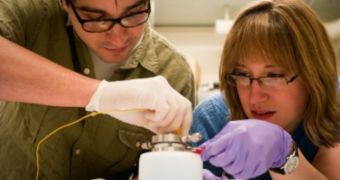Researchers at the Massachusetts Institute of Technology (MIT) say that they managed to improve on a concept they presented last year, related to improve lithium-oxygen batteries. These devices are commonly known as lithium-air batteries.
As these energy-storage devices discharge, they tend to produce solid oxidized lithium, a chemical compound that makes its way into the battery’s electrode. The key to improving efficiency is to make these components capable of absorbing more of solid lithium.
MIT investigators managed to demonstrate the technology last year, but the efficiency their batteries had was still fairly low. As such, they spent the past 12 months looking for ways to remedy this situation.
Following the new study, the group may have found an efficient solution. Experts with the research group say that constructing the electrode out of carbon fibers make the components more porous, and capable of absorbing more lithium.
The most notable thing about lithium-air batteries in general is that they store energy by capturing oxygen from air passing through them. The chemical is then combined with lithium ions, and stored inside the porous electrode.
“We grow vertically aligned arrays of carbon nanofibers using a chemical vapor deposition process. These carpet-like arrays provide a highly conductive, low-density scaffold for energy storage,” scientist Robert Mitchell says.
He holds an appointment as a graduate student at the MIT Department of Materials Science and Engineering (DMSE). Mitchell is also a coauthor of a new paper detailing the findings, which appears in the latest issue of the journal Energy and Environmental Science.
“We were able to create a novel carpet-like material – composed of more than 90 percent void space – that can be filled by the reactive material during battery operation,” scientist Yang Shao-Horn adds.
He is the Gail E. Kendall professor of mechanical engineering, and materials science and engineering at MIT, and the senior author of the new paper.

 14 DAY TRIAL //
14 DAY TRIAL //